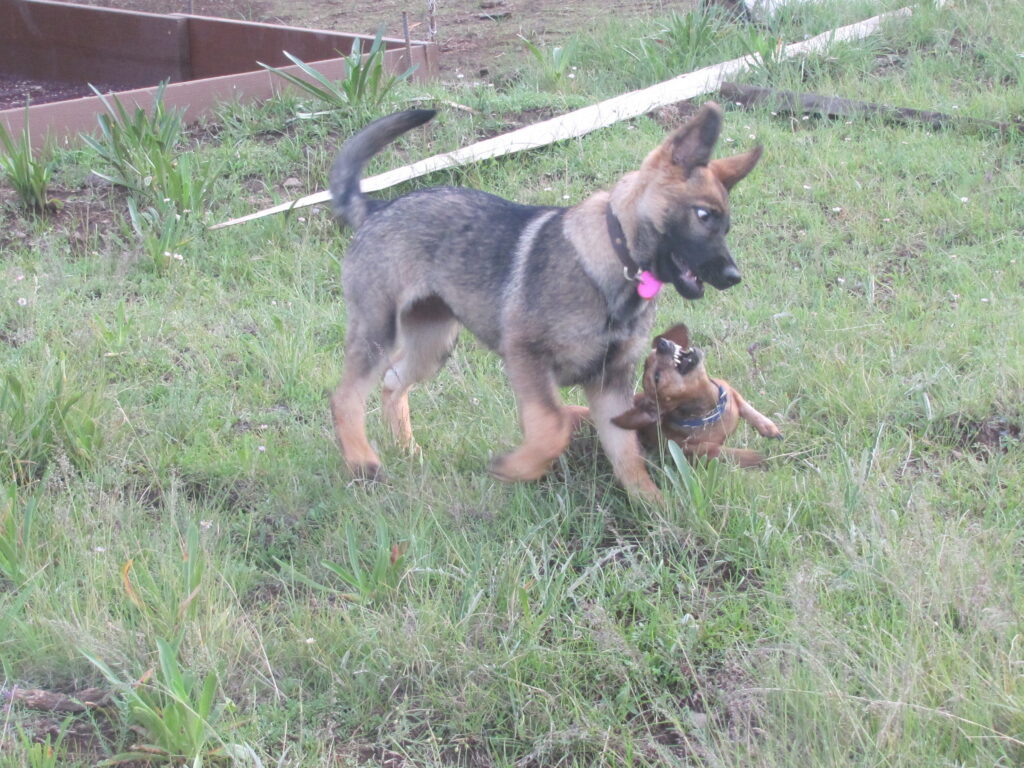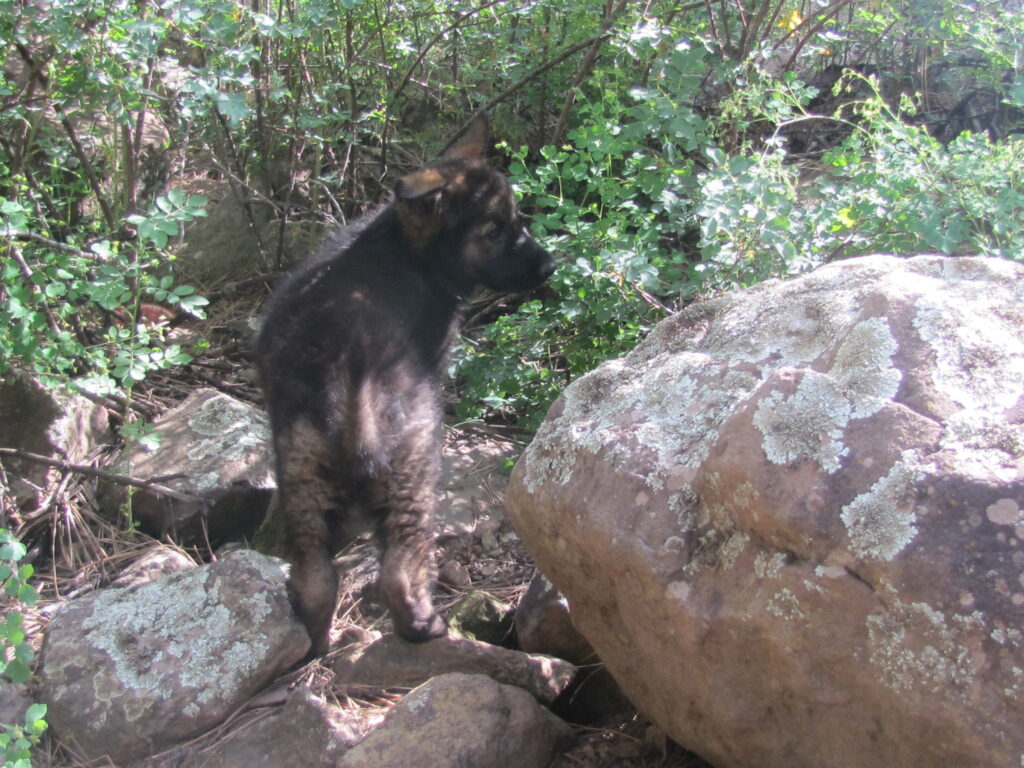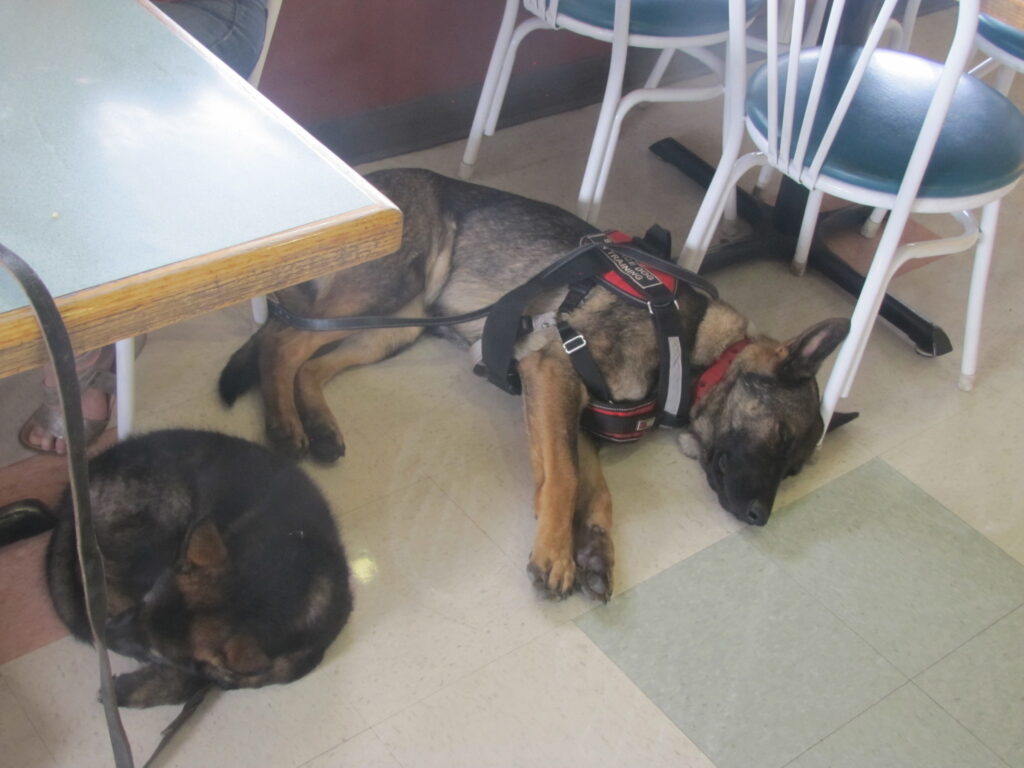We are aware that maternal stress during pregnancy adversely affects the mental and emotional development of puppies. Females who are kept in isolation in kennel runs can experience chronic stress precipitated by the unnatural living situation. Dogs are pack animals and do not emotionally thrive when kept in low-stimulation isolation. Maternal stress, induced by social isolation, is not only cruel, but it can have life-long effects on the mental well-being of the new puppy that you bring into your home. Scientific research has found that puppies born to mothers who experienced acute or chronic stress during pregnancy are at risk of developing retarded motor and learning skills. Puppies may also develop abnormal exploratory, social, and maternal behaviors. At Tre’Good German Shepherds our commitment to keep our dogs out of kennels and engaged in a normal life protects your puppy from the maternal stress experienced by dogs housed in kennels.
“There are no shortcuts to any place worth going.”
We never x-ray our females during pregnancy. It is a common commercial practice to x-ray pregnant females to determine how many puppies are going to be in a litter so that reservations can be taken. The practice puts puppies at risk of developing cancer at a young age. We stopped doing X-rays on humans during pregnancy because of the increased risk of the child developing cancer later in life. Dogs are no different than humans in their response to prenatal radiation exposure.
Shepherd moms maintain their routine during pregnancy. We add maternal “TTouch” and massage to keep our girls relaxed and their endorphins high, which has a very positive impact on the developing puppies. During the last week of pregnancy, the whelping box is set up inside the handler’s home. The puppies will be born with the assistance of the dog’s handler in her familiar family surroundings.

We are not proponents of neonatal stress stimulation for puppies. The fad began in the early 1960s based on experimental research. Recent studies reveal that neonatal stress may have a detrimental impact on brain development and metabolic health. The only benefit of early stress may be an increase in maternal licking and attention given to the puppies when they return to the whelping box. We do not believe neonatal stress stimulation is beneficial. Instead, we use methods to increase maternal licking and care of the new baby puppies in the whelping box.
1-When the puppy’s ears open, we immediately begin to present all the sounds of the world. Once again, puppies will not be frightened by the sounds they hear as soon as their ears develop. At this stage, we add desensitization recordings and the sounds of television to the whelping area.
1-We now begin to enrich the puppies’ environment. Enriched environments increase cortical thickness and synaptic size, instruct neurological development, and increase IQ, learning ability, and memory. We know that if we lock a child in a closet with food and water but little stimulation, the child will emerge later in development as a fragment of the person he could have been. But, raising dogs in this manner is standard practice. Under common industry breeding and rearing practices, our dogs emerge as something less than their true cognitive and emotional birthright.
2-As soon as the puppies desire to explore their environment, we increase the size of the whelping box and add toys, different walking surfaces, and humans for the pups to investigate. The humans now take on some of the physical touch and nurturing the puppies have been getting from mom. We begin to transfer the release of oxytocin (the bonding hormone) from interactions solely with mom to the new physical touch and nurturing they receive from humans.
1-The puppies now enter preschool. The preschool room is filled with wonderful climbing gear, toys, and visual and sensory experiences. All explorations are at each puppy’s pace. Nothing is forced on a puppy. All learning at this stage is self-directed. A puppy needs to develop a sense of competence in his/her ability to tackle life experiences. Humans support the puppies newly entering preschool. They offer cuddling as well as a conversation to develop the language centers of the pups’ brains. Dogs do not arrive pre-wired for human language, but they do process our language in the same area of their brains as we do. It is amazing that dogs can learn our language. Never underestimate their abilities. Dogs can learn the meaning of our words. They can also learn the difference between nouns, verbs, praise, and negatives, as well as sentence chains.
2-The pups begin to wean off their dependence on their mothers’ milk, and soft food is introduced. We now use the food to teach the puppies that humans are not only a source of love but also food. When we begin to feed the pups, they learn their first 2-word command, “here-here,” which will be their recall command for the rest of their lives.
1-The pups have now graduated from kindergarten. They move outside to the puppy yard, where they find new obstacles, wobbleboards, water play, plastic-filled pools, swings, and other environmental stimulation.
If the mom is willing at seven weeks, the puppies are introduced to our other dogs. They spend time playing with their parents, grandparents, and other dogs. Their time together helps refine the polite, social behaviors of the puppies, which they will need to socialize with other dogs and their new human family. Under the watchful eye of their elders, the puppies begin to explore the natural environment. We cannot overstate the importance of free exploration of the natural world. The pups’ neurological development is greatly enhanced while they romp together in the pastures and forests of their home environment.


A SEVEN WEEK OLD PUPPY TAKES A PEEK AT MOM AND DAD BEFORE ENTERING AN ENVIRONMENT
We have found over the years that German Shepherds have different critical fear periods. Critical fear periods seem to come early to Shepherds. Most breeds are out in the world early and brought back home around eight weeks to ride out their fear periods. Shepherds are ready to enter the world around eight weeks after a long enrichment period at home between 3 to 8 weeks of age. This is our experience with our line of German Shepherds. We are not saying this is the correct time frame for other breeds of dogs or all Shepherds. But we do wonder if Shepherds have dropped out of service work not only because of breeding for the wrong qualities but because they are brought out into the world to early. And then placed in lock down when they should be out learning about the human world.
Our puppies are not placed in a home until they are ten weeks old. We do this for two reasons. First, parents who are not locked in a kennel or whelping room do not tire of their pups but continue to be active participants in their upbringing. We now expand basic puppy training with nature hikes. The puppies follow their parents and a handler through the forest. Problem-solving begins as the puppies decide how to go through, over, and under natural obstacles to keep up with the pack. Puppies also learn to look up to their ultimate leader and protector, their human, during these hikes. The handler is always there to show a pup how to search out ways to overcome a difficult obstacle during the walk. Second, puppies that are not prematurely removed from their parents tend to have a confident, joyful, balanced demeanor. We know that attachment parenting develops emotionally intelligent, confident human beings. We believe it works the same for dogs. By supporting and allowing the natural bond between pups and their mothers, our pups are confident and ready to bond strongly with their new family.
Teaching basic obedience commands begins during the walks, using food as a motivator for the always-hungry pups. We utilize their parents as role models for the obedience command execution. The pups are always very curious about our interactions with their parents. They watch and learn as their parents perform basic obedience commands reinforced with yummy treats. The pups quickly begin to imitate their parent’s response to the obedience commands. By using imitation for early puppy training, we try to eliminate any connection that could develop between training and mental/emotional stress. Because we use positive reinforcement techniques “only” during puppy training (no compulsion), our puppies associate obedience work with safety, fun, and play. Our early work with our puppies creates dogs that are easy to train for any job you have planned for them.
Every Tre’Good puppy arrives at your home knowing basic obedience commands. He/she will be leash broke and will have a basic understanding of housebreaking. It is very important to us that your new family member makes a smooth transition into your home. We dedicate many hours to the development of each individual puppy. It is our goal that every Tre’Good pup quickly becomes a valued member of your family. Our puppies do not go from a kennel to your home. Before they arrive, they have experienced weeks of handling, enrichment, socialization, and training. Proper training and socialization of a young puppy are a precise, time-consuming, and labor-intensive endeavor. This is why we have developed our program. We want our families to know the joy of dog ownership, which is created through a commitment to early learning. We take the guesswork out of how to bring up your new pup. We did it for you so you both can have an enriched and loving relationship in the future.
Below, a puppy is learning how to behave and relax during a restaurant meal by imitating the behavior of our medical alert service dog. The trainer did not intervene; the puppy learned what was expected of her in a new, highly stimulating environment. By merely following the lead of her doggie mentor, she painlessly adapted to this unique situation. Whether this pup becomes a service dog or a family companion, she knows how to behave in restaurants, outdoor cafes, or at your dinner table.
